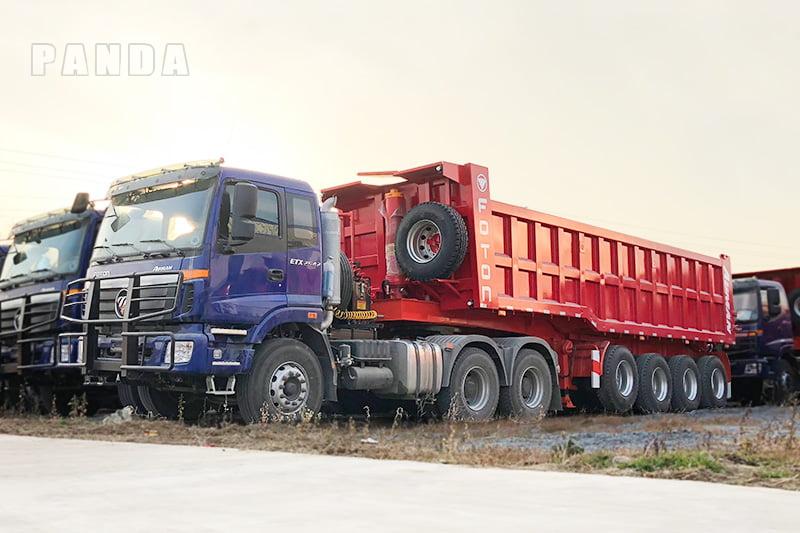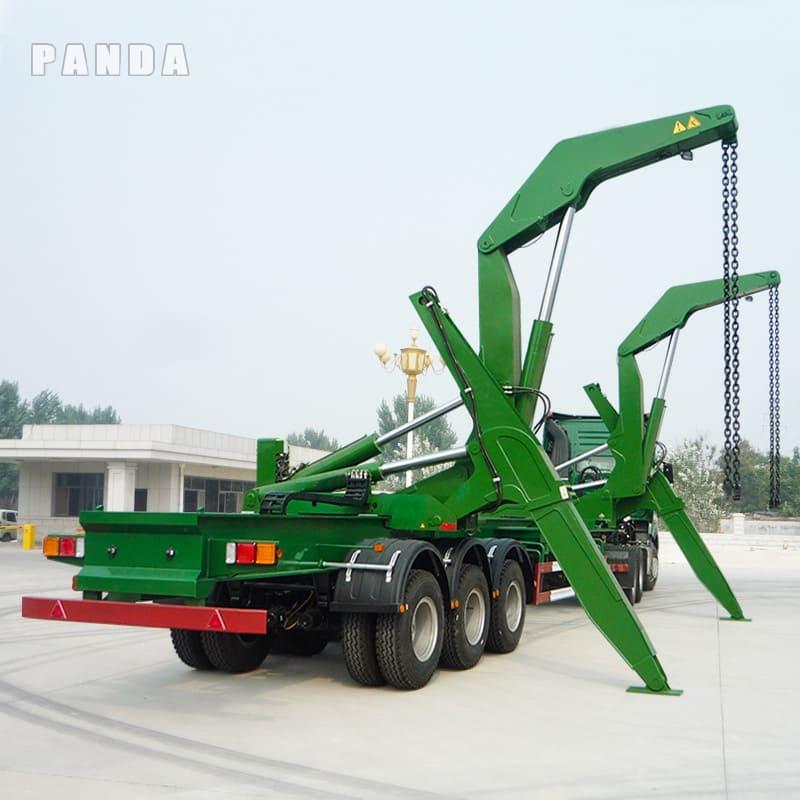Have you ever wondered how many tons of rock in a dump truck it can carry? 🤔 Well, the answer depends on a few factors. Most dump trucks can haul anywhere from 10 to 40 tons of material.

Factors That Affect How Much Rock a Dump Truck Can Carry
When figuring out how much rock a dump truck can carry, several things matter. Let’s break it down to understand what affects a dump truck’s load. 🚛
Truck Size and Design
The size and design of a dump truck decide how much it can carry. Bigger trucks with more axles and larger beds hold heavier loads than smaller ones. For example, a 40-ton truck is for very heavy loads, while regular trucks carry lighter ones.
Here’s a simple comparison of truck models:
| Model | Max Load (Tons) | Axles | Common Uses |
|---|---|---|---|
| 50 Ton | 50 | 3 | Medium loads, like at construction sites |
| 60 Ton | 60 | 3 | Heavy items like gravel or ore |
| 80 Ton | 80 | 4-5 | Long trips with bulk materials |
| 100 Ton | 100 | 4-6 | Very heavy items, like big machines |
The truck’s Gross Vehicle Weight Rating (GVWR) is also important. This tells the heaviest weight a truck can safely carry, including its own weight. Subtract the truck’s weight from the GVWR to find the payload, which is the actual load it can carry.
Material Weight and Type
Not all rocks weigh the same! The type and weight of the material being carried affect how much the truck can hold. For instance, crushed granite is heavier than lava rock, so it takes up less space but weighs more.
Here’s a table showing the weights of common materials:
| Material Type | Weight (kg/m³) |
|---|---|
| Rock Base Gravel | 1520 |
| Crushed Granite Gravel | 2460 – 2800 |
| Lava Rock | 500 – 750 |
| Pea Gravel | 1788 |
| Shells Gravel | 500 – 700 |
| Shale Gravel | 2060 – 2670 |
So, if you’re wondering how much gravel a truck can carry, think about its weight. Heavier gravel means less volume the truck can hold.
Rules About Weight and Roads
Lastly, rules about weight and roads are very important. Federal and state laws keep roads safe and prevent damage. The Federal Bridge Law (FBL) sets weight limits based on axle spacing, but state rules can differ.
Here’s a look at weight limits for different trucks:
| Truck Type | GVWR (lbs) | Max Weight Limit (Federal) |
|---|---|---|
| Heavy-duty trucks | Up to 80,000 | 80,000 |
| Medium-duty trucks | 26,001 to 33,000 | Varies by state |
| Light-duty trucks | 10,000 to 26,000 | Varies by state |
| Single-axle trucks | Up to 20,000 | 20,000 |
| Tandem-axle trucks | Up to 34,000 | 34,000 |
These rules make sure trucks stay safe and don’t overload. Overloading can cause fines, accidents, or truck damage. Always check local rules before loading your truck.
By knowing these factors, you can better guess how much a dump truck can carry. Whether it’s gravel, stone, or lava rock, understanding limits saves time and money. 😊
Types of Dump Trucks and Their Load Capacities

Not all dump trucks are the same. Each type has a special design and load size. Let’s explore the common types and what they can carry. 🚛
Standard Dump Trucks
Standard dump trucks are common on construction sites. They have a simple design with a truck body and a tilting bed. These trucks are useful for many tasks, like moving gravel or crushed stone.
Here’s a table of their load sizes:
| Truck Type | Axles | Load Size (Tons) |
|---|---|---|
| 2-Axle Standard Truck | 2 | 10-20 |
| 3-Axle Standard Truck | 3 | 20-30 |
| 4-Axle Standard Truck | 4 | 25-35 |
Standard dump trucks usually carry 10 to 20 tons. The number of axles affects how much they can hold. These trucks are great for short trips and tight spaces. They are reliable for daily jobs. 😊
Transfer Dump Trucks
Transfer dump trucks are different. They have a trailer that holds extra material. The trailer can be removed and unloaded separately. These trucks are perfect for carrying large amounts of material.
Here’s a table of their load sizes:
| Truck Type | Load Size (Tons) |
|---|---|
| Single-Axle Transfer Truck | 10-15 |
| Tandem-Axle Transfer Truck | 16-25 |
| Tri-Axle Transfer Truck | 26-30 |
These trucks are good for long trips. They are often used in road projects to move gravel or asphalt.
Side Dump Trucks
Side dump trucks unload by tipping the bed to the side. This design makes them safer on uneven ground. They are great for quick unloading and stable jobs.
Here’s a table of their load sizes:
| Truck Type | Load Size (Tons) |
|---|---|
| Standard Side Dump Truck | 20-30 |
| Heavy-Duty Side Dump Truck | 30-40 |
Side dump trucks are very efficient. They are often used in big projects like mining or digging. They save time and work well on large jobs. ⏱️
Each dump truck type has its own benefits. Pick the right one based on your project’s needs, whether it’s small or large.
Dump Semi Trailers
Dump semi trailers are great for moving lots of rock far. They connect to a semi-truck and use hydraulics to lift the bed for unloading. These trailers are common in mining, construction, and farming. They are super useful! 🚛
Here’s why tipper semi trailers are special:
- High capacity: They hold 30-60 tons, depending on the model.
- Efficiency: Best for moving large loads quickly and easily.
- Flexibility: Can carry gravel, sand, or crushed stone.
Pro Tip: Always check your truck and trailer weight limits. Overloading can cause damage or fines.
Dump semi trailers are perfect for big jobs needing speed and capacity. They save time and make work easier. 😊
Side Tipper Trailer
Side tipper trailers are another great choice for carrying rock. Unlike other dump trailers, they unload by tipping to the side. This makes them safer and steadier on uneven ground. They are popular in mining and big construction projects.
Why pick a side tipper trailer?
- Safety: Side-tipping lowers the chance of tipping over.
- Speed: Unloading is faster, saving time on the job.
- Durability: Strong enough for tough materials like rocks.
Here’s a table of their load capacities:
| Trailer Type | Load Capacity (Tons) |
|---|---|
| Tandem-Axle Tipper | 20-30 |
| 3 Axle | 30-60 |
| 4-Axle Tipper | 60-100 |
Note: Side tipper trailers work best in open areas with space to tip safely.
For heavy-duty jobs, side tipper trailers are a smart pick. They are safe, strong, and very efficient. 🚜
How to Calculate Dump Truck Capacity for Rock
Figuring out the dump truck capacity for rock might seem tricky, but it’s actually pretty simple once you break it down. Let me walk you through it step by step. 🚛
Understanding Material Density (e.g., Crushed Stone vs. Gravel)
The first thing to know is that not all materials weigh the same. For example, crushed stone is denser than gravel, so it weighs more per cubic yard. This means a load of gravel will take up more space but weigh less than the same volume of crushed stone.
Here’s a quick comparison of material densities:
| Material Type | Approx. Weight (Tons per Cubic Yard) |
|---|---|
| Crushed Stone | 1.5 – 1.7 |
| Gravel | 1.2 – 1.4 |
| Sand | 1.3 – 1.5 |
To calculate how many tons of gravel or stone your truck can carry, you’ll need to know the material’s density. This helps convert cubic yards to tons accurately.
Pro Tip: Always double-check the material type and density before loading your truck. It saves time and prevents overloading. 😊
Using Truck Specifications to Determine Capacity
Every dump truck has a specific load capacity, which depends on its size and design. Start by checking the truck’s Gross Vehicle Weight Rating (GVWR). This tells you the maximum load weight the truck can handle, including its own weight. Subtract the truck’s empty weight from the GVWR to find the payload.
For example:
- A truck with a GVWR of 50,000 lbs and an empty weight of 30,000 lbs has a payload of 20,000 lbs (or 10 tons).
Next, consider the truck bed’s volume. Most dump trucks list their capacity in cubic yards. To figure out how many cubic yards are in a dump truck, check the manufacturer’s specifications. Then, multiply the volume by the material’s density to estimate the weight.
Accounting for Weight Limits and Safety Considerations
Safety is key when calculating dump truck load capacity. Overloading can damage the truck, lead to fines, or even cause accidents. Always stay within the truck’s maximum load weight and follow local road regulations.
Here’s a quick checklist to ensure safety:
- Know the truck’s GVWR and payload.
- Check the material’s density and weight.
- Follow legal weight limits for your area.
Reminder: If you’re unsure how much gravel or rock to load, consult the truck’s manual or a professional. It’s better to be safe than sorry!
By understanding material density, using truck specs, and considering safety, you can calculate dump truck capacity with confidence. Whether you’re hauling gravel, crushed stone, or sand, these steps will help you get the job done efficiently. 😊
Comparison of Dump Truck Load Capacities

Overview of truck types, average capacities, and typical uses
Dump trucks come in different types, each with unique uses. Some are better for small jobs, while others handle massive loads. Let’s look at the main types and what they’re good for. 🚛
Here’s a simple table showing truck types, load sizes, and uses:
| Truck Type | Average Load Capacity (Tons) | Typical Uses |
|---|---|---|
| Rear Dump Trucks | 10-25 | Small construction, roadwork |
| Side Dump Trucks | 20-40 | Mining, big construction projects |
| Roll-Off Trucks | 10-15 | Trash removal, demolition debris |
| On-Road Dump Trucks | 10-30 | City construction, landscaping |
| Off-Road Dump Trucks | 50-150+ | Mining, heavy earthmoving |
Each truck type is made for specific tasks. Rear dump trucks are great for smaller jobs. They carry up to 25 tons and are easy to move. Off-road dump trucks are huge and can haul over 150 tons. These are best for mining or moving large amounts of dirt.
Side dump trucks are perfect for big projects. They unload to the side, which is safer on uneven ground. Roll-off trucks are ideal for waste and demolition. Their containers can be removed, making them very useful.
Pro Tip: Choose the right truck for your project. The wrong one can waste time and money.
Knowing what each truck can do helps you plan better. Whether it’s a small yard job or a big mining task, there’s a truck that fits your needs. 😊
How many tons of rock can a dump truck carry? It depends on the truck’s type, size, and the material. Standard dump trucks usually carry 10 to 16 tons. Larger trucks, like 40-ton models, can handle 25 tons or more. 🚛
Several things affect how much a dump truck can hold. Material weight is important—heavier rocks like crushed stone take up less space. Rules about weight limits also matter. These rules keep roads safe and prevent damage. Here’s a simple breakdown of key factors:
| Factor | Description |
|---|---|
| Truck Size | Bigger trucks carry more but may not fit everywhere. |
| Construction | Stronger trucks can handle heavier loads. |
| Weight Limits | Laws set maximum weight for safety and road protection. |
| Material Density | Heavier materials mean less space for loading. |
| Average Capacity | Most trucks carry 10 to 25 tons, depending on their design. |
When planning, think about these factors. Whether moving gravel or estimating a truck’s load, these tips help you decide better. 😊
Pro Tip: Always check your truck’s specs and local rules before loading. Overloading can cause accidents or fines, so stay safe!
Knowing how many tons a dump truck can carry saves time and money. Whether it’s a small truck or a 40-ton one, understanding its capacity keeps your project on track. 🚜
FAQ
What is the average weight a dump truck can carry?
Most dump trucks carry between 10 to 25 tons of material. Smaller trucks handle lighter loads, while larger models can haul up to 40 tons or more. Always check the truck’s specifications for accurate capacity. 🚛
How do I calculate how much rock I need for my project?
Multiply the area (length × width) by the depth to find the volume in cubic yards. Then, use the material’s density to convert cubic yards to tons. For example:
- Gravel: 1.2–1.4 tons per cubic yard
- Crushed stone: 1.5–1.7 tons per cubic yard
Can I overload a dump truck?
No, overloading is unsafe and illegal. It can damage the truck, cause accidents, or lead to fines. Always follow the truck’s Gross Vehicle Weight Rating (GVWR) and local road regulations. Safety first! 😊
What’s the difference between a standard dump truck and a side dump truck?
- Standard Dump Truck: Unloads material by tilting the bed backward. Great for tight spaces.
- Side Dump Truck: Tips the bed to the side for faster unloading. Ideal for large, open areas.
Why does material density matter when loading a dump truck?
Heavier materials, like crushed stone, take up less space but weigh more. Lighter materials, like lava rock, fill more volume but weigh less. Knowing the density helps you load the truck safely and efficiently.
Pro Tip: Always double-check the material type before loading to avoid surprises! 😊




